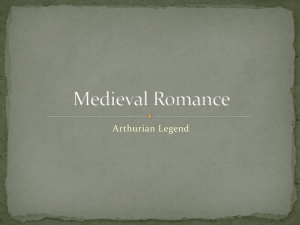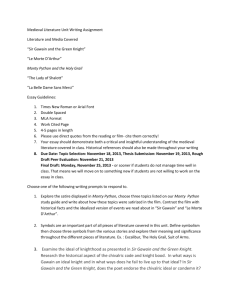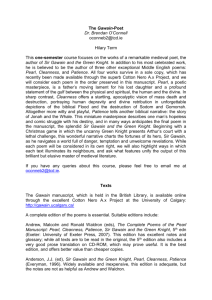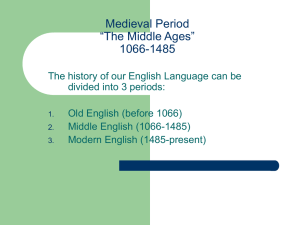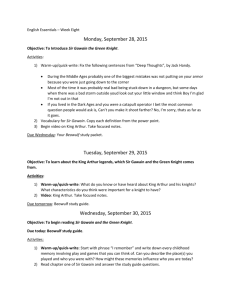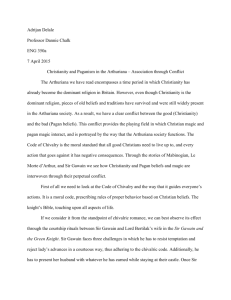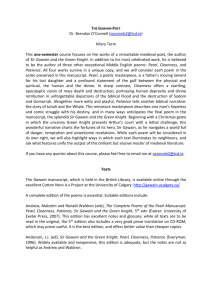Response-Paper
advertisement
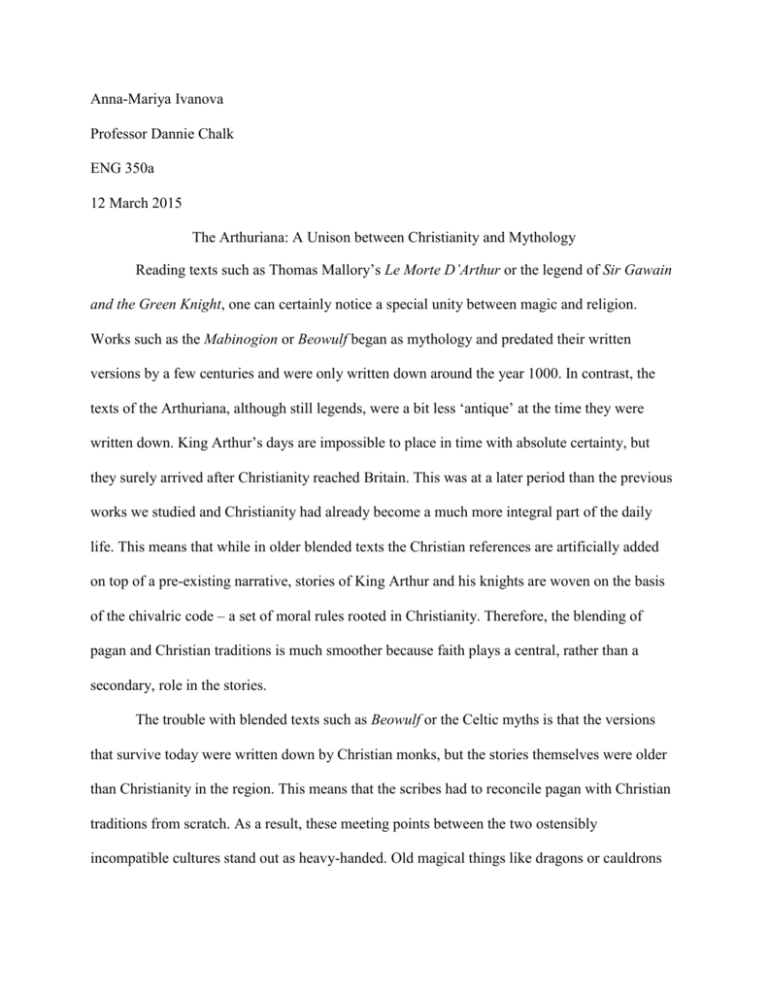
Anna-Mariya Ivanova Professor Dannie Chalk ENG 350a 12 March 2015 The Arthuriana: A Unison between Christianity and Mythology Reading texts such as Thomas Mallory’s Le Morte D’Arthur or the legend of Sir Gawain and the Green Knight, one can certainly notice a special unity between magic and religion. Works such as the Mabinogion or Beowulf began as mythology and predated their written versions by a few centuries and were only written down around the year 1000. In contrast, the texts of the Arthuriana, although still legends, were a bit less ‘antique’ at the time they were written down. King Arthur’s days are impossible to place in time with absolute certainty, but they surely arrived after Christianity reached Britain. This was at a later period than the previous works we studied and Christianity had already become a much more integral part of the daily life. This means that while in older blended texts the Christian references are artificially added on top of a pre-existing narrative, stories of King Arthur and his knights are woven on the basis of the chivalric code – a set of moral rules rooted in Christianity. Therefore, the blending of pagan and Christian traditions is much smoother because faith plays a central, rather than a secondary, role in the stories. The trouble with blended texts such as Beowulf or the Celtic myths is that the versions that survive today were written down by Christian monks, but the stories themselves were older than Christianity in the region. This means that the scribes had to reconcile pagan with Christian traditions from scratch. As a result, these meeting points between the two ostensibly incompatible cultures stand out as heavy-handed. Old magical things like dragons or cauldrons were made to fit in with the Christian worldview by being assigned new meanings, and this process was not always seamless. In comparison, the Arthuriana legends appear as better crafted works, because they did originate in a society that had already awoken to Christianity. Instead of trying to redefine old pagan concepts of magic, authors were creating their own stories based on the new religious ethics, and incorporating pagan beliefs as secondary elements. Certain conventions remained the same – magics could still be differentiated into four categories (religious, demonic, scientific, natural); sorcery was still perceived in a negative light, for example the character of Morgan le Fey, the sorceress who is always plotting against King Arthur and his knights. Sorcery is also the source of Sir Gawain’s shame at the end of Sir Gawain and the Green Knight because Gawain is secretly wearing the girdle when he comes to face the knight. However, in the story there are detailed descriptions of the holy symbols and armor Gawain wears when he sets on his journey. His special symbol is the pentangle that symbolizes the Five Wounds of Jesus and the Five Joys of the Virgin. It is quite easy then to make a comparison between these holy Christian items and the girdle, which is pagan even in color (green). The use of the girdle along with the armor is interpreted as sorcery, i.e. cheating, because it means the Faith is not powerful enough for Gawain. It is not the girdle per se that shames the knight; it is the fact that he doubted God’s power and protection. An important consideration is the environment in which each of these stories were meant to thrive. Myths and epics are based on popular knowledge and exist in folklore culture, accessible to all – most of them came down from the oral tradition precisely to ensure this kind of accessibility. The Arthuriana is different in this respect, because as a chivalric romance it was meant for the higher tiers of society. This genre means that the main characters are knights, abiding the code of chivalry, and the story features fantastical elements such as dragons or fairies. Certainly it was popular enough for all British people to have heard the stories, but they were mostly read by the aristocracy in their leisure time - at social gatherings. This kind of storytelling is primarily for entertainment purposes. As a result, it incorporates many elements of these people’s culture and norms to which they could relate during reading time. For example, the long recurrent episodes about hunting in Sir Gawain and the Green Knight, as well as the numerous descriptions in great detail of fabrics, jewels, and other items of luxury are part of the story because they were pleasing to the upper class, whose lives included all of these things. The whole narrative of the Arthuriana is based on the chivalric code. The genre demands that there be noble quests for the knights to put their qualities to the test – and these coincide with Christian virtues. For instance, the temptation that Sir Gawain faces is that he has to find a courteous way to refuse a lady’s advances, in accordance with the limitations of chivalric love. This is the perfect challenge for him, because instead of bravery or strength, Gawain is known for his excellent manners. In a religious sense, he faces temptation repeatedly and resists it, except for the last day. Accepting the lady’s girdle is a mistake firstly because it makes him break the chivalric code when he does not give it back to Lord Bertilak as agreed by their bet, and secondly because him relying on the girdle’s pagan powers shows that he distrusts God. In order to wash away the sin, he has to confess to a priest (the Green Knight who also happen to be supernatural) and show penance (his wound and disenchanted girdle that no longer has any power), and eventually be absolved. Another example of a character whose breaking of the chivalric code alters the story is Lancelot and his love for Guinevere. While it was expected for a knight to flirt with his queen and actually love her in faith, it was forbidden to consummate this love. Lancelot and Guinevere disregard that and this brings the downfall of Camelot. What is important, however, is that both of them realize their sin and choose to repent. In Book Twenty-One they forsake their old lives and their passionate love by serving the Church till the end of their lives. This act is meant to rectify the sin and return them back into God’s grace. Discussing magic in the Arthuriana, one must definitely look at the two most magical characters who drive the plot – Merlin and Morgan le Fey. To start with, the inception of Merlin can be found in the Taliesin – a story often considered a part of the Mabinogion. He gains his magic by mistake from a powerful potion and after a shape-shifting chase with Caridwen who eventually swallows him and becomes pregnant. He is then reborn as a human being with supernatural powers which is seen in a positive light, because in Christian understanding, it means that his powers were a gift from God. More specifically, he is a bard, thus combining the pagan notions of the power in music with the Christian belief that it was bestowed upon him by God. In Le Morte D’Arthur Merlin appears in the service of King Arthur, because he is known for his wisdom and ability to see the future. Therefore, this use of magic is legitimate, as everyone is aware of it and Merlin’s service in Arthur’s court is no secret. Unlike Merlin, Morgan le Fey is not perceived as a good character. She is not born with her powers, but learns them at a nunnery. It cannot be said for certain that she received this knowledge from God, so her learned magic remains of suspicious origin – and this means the source could be evil. More importantly, she uses her magic in secretive ways, casting glamours or enchanting other people to do her bidding. This practice falls under the category of sorcery, a dishonest “cheating” type of behavior that does not fit in the Christian morale. Indeed, she never uses her powers to do good. For example, in Book Four, Chapter XI Sir Accolon confesses he tried to kill King Arthur at Morgan’s bidding (Le Morte D’Arthur 102). In Sir Gawain and the Green Knight it is revealed in the end that Morgan le Fey is the one who cast a glamour upon Lord Bertilak and sent him to challenge King Arthur’s court because she wanted to scare Guinevere (stanza 99). To conclude, although magic is ever-present in Le Morte D’Arthur and Sir Gawaine and the Green Knight, it no longer plays the central role plot-wise. It has stepped back, opening up more space for Christian notions and morale which guide the characters along their paths to challenges meant to test their faith. As a result, this type of stories employ a much more subtle and harmonious unification of pagan and Christian ideas than earlier British texts.
